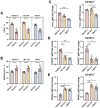Three-Dimensional Model Analysis Revealed Differential Cytotoxic Effects of the NK-92 Cell Line and Primary NK Cells on Breast and Ovarian Carcinoma Cell Lines Mediated by Variations in Receptor-Ligand Interactions and Soluble Factor Profiles
- PMID: 39457710
- PMCID: PMC11504426
- DOI: 10.3390/biomedicines12102398
Three-Dimensional Model Analysis Revealed Differential Cytotoxic Effects of the NK-92 Cell Line and Primary NK Cells on Breast and Ovarian Carcinoma Cell Lines Mediated by Variations in Receptor-Ligand Interactions and Soluble Factor Profiles
Abstract
Background/objectives: The functional activity of a certain tumor determines the effectiveness of primary NK cells and NK-92 cell line-based cancer therapy; their therapeutic effectiveness against different tumors can vary. This work provides a direct simultaneous comparison of the cytotoxic effects of in vitro-activated peripheral NK (pNK) cells and NK-92 cells in spheroid models of BT-474, MCF7 and SKOV-3 carcinomas and uncovers the reasons for the differential effectiveness of NK cells against tumors. Methods: Tumor spheroids of similar size and shape, obtained from agarose molds, were incubated with NK-92 or pNK cells for 24 h. Tumor cell death was detected using flow cytometry or confocal microscopy. Cytokine production, granzyme B levels and NK cell degranulation analyses were performed, along with pNK and target-cell phenotypic characterization. Results: While NK-92 and pNK cells lysed BT-474 spheroids with comparably low efficiency, pNK cells were more capable of eliminating MCF7 and SKOV-3 spheroids than NK-92 cells were. The results of the functional and phenotypic analyses strongly support the participation of the NKG2D-NKG2DL pathway in pNK cell activation induced by the most sensitive cytotoxic attack on SKOV-3 spheroids, whereas the CX3CR1-CX3CL1 axis appears to be involved in the pNK reaction against MCF-7 spheroids. Conclusions: We provide a new approach for the preliminary identification of the most promising NK cell receptors that can alter the effectiveness of cancer therapy depending on the specific tumor type. Using this approach, NK-92 cells or pNK subsets can be selected for further accumulation and/or genetic modification to improve specificity and reactivity.
Keywords: NK cells; NK-92; breast cancer; ovarian cancer; tumor spheroids model.
Conflict of interest statement
The authors declare no conflicts of interest. The funders had no role in the design of the study; in the collection, analyses, or interpretation of data; in the writing of the manuscript; or in the decision to publish the results.
Figures






Similar articles
-
Ex vivo expanded allogeneic natural killer cells have potent cytolytic activity against cancer cells through different receptor-ligand interactions.J Exp Clin Cancer Res. 2021 Oct 23;40(1):333. doi: 10.1186/s13046-021-02089-0. J Exp Clin Cancer Res. 2021. PMID: 34686187 Free PMC article.
-
CBLB ablation with CRISPR/Cas9 enhances cytotoxicity of human placental stem cell-derived NK cells for cancer immunotherapy.J Immunother Cancer. 2021 Mar;9(3):e001975. doi: 10.1136/jitc-2020-001975. J Immunother Cancer. 2021. PMID: 33741730 Free PMC article.
-
The low cytotoxic activity of peripheral blood NK cells may relate to unexplained recurrent miscarriage.Am J Reprod Immunol. 2021 Jun;85(6):e13388. doi: 10.1111/aji.13388. Epub 2021 Jan 27. Am J Reprod Immunol. 2021. PMID: 33410220
-
Characterization and utilization of a monoclonal antibody inhibiting porcine natural killer cell activity for isolation of natural killer and killer cells.J Immunol. 1990 Jun 1;144(11):4452-62. J Immunol. 1990. PMID: 1971298
-
Leveraging NKG2D Ligands in Immuno-Oncology.Front Immunol. 2021 Jul 29;12:713158. doi: 10.3389/fimmu.2021.713158. eCollection 2021. Front Immunol. 2021. PMID: 34394116 Free PMC article. Review.
References
Grants and funding
LinkOut - more resources
Full Text Sources
Research Materials
Miscellaneous

